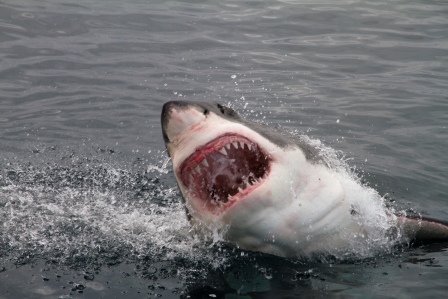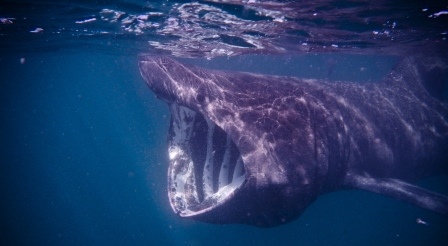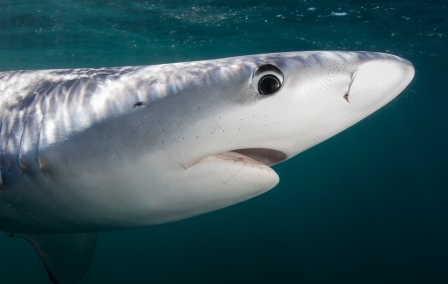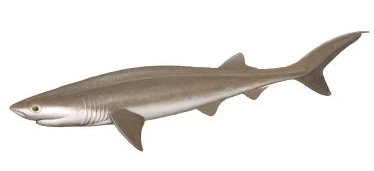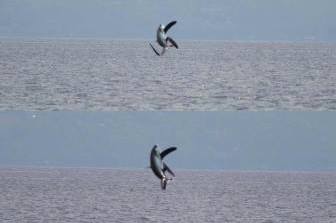Newport, Oregon— Oregonians are no strangers to large animals with lots of teeth. Veterans of Oregon’s incredible wilderness know the importance of vigilance and taking precautionary steps to prevent dangerous encounters with bears, cougars or, dare we say, Bigfoot.
But as most people know—and fear—toothy animals don’t stop at the shore. The waters off the Oregon coast are home to at least seventeen species of sharks of all shapes, sizes and notoriety (let’s just say we’d rather encounter the filter-feeding basking shark than a hungry great white).
Four of the shark species native to the Oregon coast, including the 8 ft. long broadnose sevengill shark, can be found in the Oregon Coast Aquarium’s Open Sea exhibit. The Aquarium even has a Guest Dive Program that allows dive-certified guests to get face-to-face with the sharks housed in the shark habitat.
Although sharks typically get a bad rap, most of Oregon’s sharks are actually quite harmless and non-threatening. The likelihood of a shark attack is extremely low, and in fact, there is no record of a fatal shark attack in Oregon.
This guide to the seventeen species of sharks on the Oregon coast presents basic facts of each species as well as the shark species’ historical relationship to humans:
GREAT WHITE SHARK
The great white shark may well be the most feared animal on the planet since the release of “JAWS” and subsequent media representation. While not the largest shark on this list, they certainly are the most powerful and dangerous. Great white sharks grow up to 20 feet and can weigh almost 4,000 lbs. They are found all along the west coast, typically in water temperatures between 54 to 75 degrees Fahrenheit.
Human encounters:
Every recorded encounter with a great white shark in Oregon has been an unprovoked non-lethal attack on a surfer. Marine mammals, like seals and sea lions, are the primary prey targets for these predatory sharks. It is likely that the shark mistakes the surfer for one of their prey species, as this species is not typically labeled as aggressive. It is the shark’s size and the rapid nature of the attack, however, that make encounters with white sharks especially dangerous.
Of the 28 recorded unprovoked shark attacks in Oregon, 27 of these have involved great white sharks. The most recent great white shark attack in Oregon was in October of 2016 at Indian Beach at Ecola State park. The surfer suffered a leg injury after the white shark bit his leg.
BASKING SHARK
Growing up to 40 feet long, basking sharks top this list for largest size. With enormous gaping mouths and an uncanny resemblance to white sharks, it is easy to be intimidated by these mysterious, but harmless fish. No need to fear, though, because basking sharks are all “bask” and no bite. Literally—this gentle giant swims near the water’s surface, basking in the sun while filter feeding on plankton. Ironically, this shark still has more teeth than any other species of shark on Earth.
PACIFIC BLUE SHARK
The ubiquitous blue shark lives in every coastal water except for Antarctica. Named for their bright blue coloration, they have a long, narrow body about 10 ft. long. This threatened species is rarely hunted by other marine life, but it is a frequent victim of bycatch. These sharks feed on invertebrates like octopus and squid as well as fish and the occasional seabird.
Human encounters:
The only fatal shark attack to ever occur on the Oregon coast occurred in 1975 after a fishing boat capsized with a couple onboard, 200 miles offshore of Astoria. While the man drowned, the woman was found deceased with several shark bites believed to be those of a blue shark, which are known to frequent that area. Besides this instance, there has never been a report of a blue shark attacking a human. The blue shark is a slow scavenger that typically stays in the warmer waters offshore.
BROADNOSE SEVENGILL SHARK
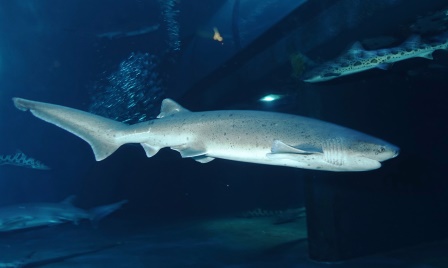
There is currently insufficient data on this shark to determine if its populations are threatened. However, because they occupy coastal waters, the sevengill shark is frequently caught as bycatch and many are unintentionally killed as a result. The Oregon Coast Aquarium has recently begun a project to tag and track broadnose sevengill sharks in the wild in order to obtain more information on this species.
Human encounters:
There have only been five recorded attacks globally (never in Oregon) by a sevengill since the 17th century—they are only known to be aggressive when feeding, mating, or provoked. Here at the Oregon Coast Aquarium, we keep our sevengills very well fed and use long poles to ensure all divers are safe while in close proximity to these sharks.
SIXGILL SHARK
The sixgill shark looks similar to the sevengill, but with six gills instead of seven (or five, like most sharks) and striking green eyes. Due to its solitary life in deep water, scientists don’t know much about it, but they think that they can live over eighty years.
Human encounters:
Sixgill sharks are considered a threatened species as they are heavily fished with a slow reproductive rate. Although there have been no attacks in Oregon, it was reported that a shoal of sixgill sharks attacked a submarine filled with camera crew while filming for Blue Planet 2. Luckily, the average beachgoer does not have to worry about encountering a sixgill since they spend most of their lives at great depths.
COMMON THRESHER SHARK
The common thresher shark grows up to 20 feet long, with an extremely long caudal (tail) fin. The fin is used like a whip for defense against predators and to capture prey. Although large in size, the shark has relatively small teeth that are used for catching fish.
Human encounters:
Known for putting up a strong fight, the common thresher is highly prized by sport fisherman, contributing to its classification as a vulnerable species. Still, this shark is quite docile and nonthreatening to humans.
LEOPARD SHARK
Perhaps one of the most strikingly beautiful sharks, the Leopard Shark is easily identified by the variegated pattern of bars and spots that extend all along its body. This unique natural camouflage helps this shark hide in the dappled sunlight that filters through the offshore kelp forests or along the rocky seabed. Leopard sharks are highly nomadic, often traveling great distances without ever revisiting the same spot twice. They are also a particularly ancient species, with fossilized examples dating back over one million years.
Human encounters:
Leopard sharks pose little to no danger to humans due to their skittish and shy nature.
PACIFIC ANGELSHARK
Pacific angelsharks dwell on the ocean floor near rocky reefs and kelp forests. Their flat bodies resemble that of rays and skates, but their pectoral fins are not attached and their large mouths are in front of the head, where they create an intense suction when feeding.
Human encounters:
One of 23 species of angelsharks, the Pacific angelshark is near threatened with extinction while other species are critically endangered due to overfishing. Although not aggressive or considered dangerous to humans, there are instances of angelsharks biting SCUBA divers when harassed.
SALMON SHARK
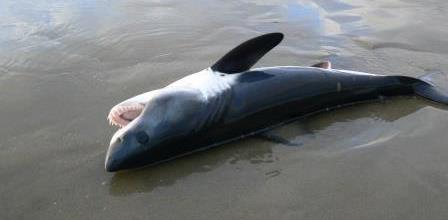
Per their namesake, salmon shark feed on salmon, squid, birds, herring and other fish. They are found in the north Pacific and have an average length of around 7 feet. Researchers have observed significant sex composition differences with salmon sharks between the eastern and western north Pacific, with eastern populations dominated by females and western populations by males. It is not known why this is.
Human encounters:
Salmon sharks can be kept and eaten by those who legally catch them, but typically they are just caught as bycatch and discarded. Fishermen view them as pests due to damage to fishing gear. Even though they are relatively large and related to dangerous species like the white shark, there has been no positively identified shark attack by a salmon shark on a human. Salmon sharks occasionally wash up on the Oregon coast, most recently near the Aquarium in Newport, Oregon!
SHORTFIN MAKO SHARK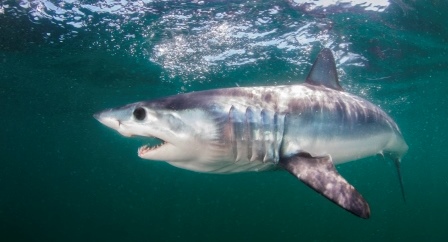
Due to the value of their fins and meat by fishermen and accidental capture, scientists estimate that populations of shortfin mako sharks have declined substantially. But due to their migratory nature, it is difficult to determine abundance and specific fishing impacts.
Human encounters:
Since mako sharks live in deeper waters, they are typically only threatening to fisherman or divers. Reports say that shortfin mako sharks have attacked a boat when hooked, and divers say that the sharks swim in a figure eight pattern prior to an attack.
SCHOOL SOUPFIN SHARK
This shark is known by a variety of names, including tope Shark, snapper Shark and school shark. It is one of the smaller Oregon species, and most of the shark’s fins are tipped in black.
Human encounters:
The soupfin has historically been caught in nets by commercial fishermen. Its meat is rich in vitamins, making it desirable in both Asian and European markets. The shark generally feeds on fish, squid and octopus along the ocean bottom or in the water column. Soupfin sharks are generally harmless, and they can be found alongside the other sharks at the Oregon Coast Aquarium.
SPINY DOGFISH
Spiny Dogfish are widely dispersed throughout the Pacific Ocean, often hunting in schools of thousands of individuals. They are opportunistic feeders, but due to their relatively small size, they prefer smaller fish, krill, squid and octopus.
Human encounters:
This small shark lives in deeper waters and is not known to attack humans. This species can also be found at the Oregon Coast Aquarium in the Open Sea exhibit.
BROWN SMOOTH-HOUND SHARK
The brown smooth-hound shark is a small, common shark species that is found in enclosed, shallow bays. It is a bottom-dweller that hunts crabs, shrimp, and small fish.
Human encounters:
Due to its small size, it is considered harmless to humans. In fact, they are often seen in Aquariums due to their adaptability to living under human care.
CATSHARK
There are three species of catshark that are native to Oregon: the brown, longnose and filetale catshark. Catsharks get their name from the way their eyes glow when reflecting light – like a cat’s eyes. An enlarged gill region allows the catshark to live in deep ocean areas with low dissolved oxygen levels.
Human encounters:
Little is known about these three species of catsharks, or catsharks in general, but they are believed to be a solitary and nocturnal species. They rarely venture into shallow water, so they are rarely (if ever) encountered by divers.
PACIFIC SLEEPER SHARK
The Pacific sleeper shark gets its name from its slow swimming through the cold, deep waters of the continental shelf all along the west coast of North America. Nonetheless, this shark is capable of silent extreme movement when hunting for octopus, rockfish, and crab. Pacific sleeper sharks have been caught that exceed 20 feet and 8000 lbs—almost the size of an adult orca.
Human encounters:
Little is known about these sharks in Oregon, but they are known to scavenge on sea lion and gray whale carcasses. Their tissue is reported to be toxic to humans due to the presence of trimethylamine, w
Sharks have survived four of the five mass extinction events and reigned as the ocean’s apex predators for hundreds of millions of years. Yet these prehistoric fish are in danger of disappearing. Overfishing, bycatch, and habitat degradation threaten shark populations worldwide. Thus, some of the species listed above, like the great white shark and basking shark, are federally protected.
You can purchase shark products, including official Air Jaws and Chris Fallows Collection t-shirts, water bottles, and plush toys from the Aquarium Gift Shop.
The Oregon Coast Aquarium is open every day this summer from 10:00 a.m. to 6:00 p.m. Visit aquarium.org or call 541-867-FISH for more information or to purchase advance tickets.
The Oregon Coast Aquarium creates unique and engaging experiences that connect you to the Oregon Coast and inspire ocean conservation. An accredited Association of Zoos & Aquariums institution, this 501(c)3 non-profit organization is ranked as one of the top 10 aquariums in the U.S. Visit us at 2820 S.E. Ferry Slip Rd., Newport, OR. www.aquarium.org, 541-867-3474. Follow us on Facebook.com/OregonCoastAquarium, or Twitter.com/OrCoastAquarium for the latest updates.


